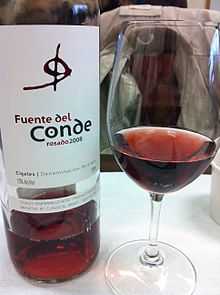Cigales

Cigales is a Spanish Denominación de Origen (DO) for wines located to the north of Valladolid (Castile and León, Spain) along both banks of the River Pisuerga.
It includes several municipalities, including Valladolid itself, Dueñas, Cabezón de Pisuerga, Cigales, Corcos del Valle, Cubillas de Santa Marta, Fuensaldaña, Mucientes, Quintanilla de Trigueros, San Martín de Valvení, Trigueros del Valle and Valoria la Buena. The DO has an extension of 574 km² and is at an altitude of 750 m above sea level. It is a relatively recent DO, having been created in 1991.
History

The first known inhabitants of this area were the Vaccaei, who were subjugated by the ancient Romans in the 2nd century BC. As in the rest of the peninsula, the Romans introduced vines along with other agricultural innovations. The number of vineyards increased significantly during the Middle Ages due to the influence of the monasteries.
Mary of Austria, Queen of Hungary, died in Cigales in 1558.
Climate
The Cigales DO has a continental climate (long hot summers, cold winters) with an Atlantic maritime influence and strong temperature variations. Temperatures often fall below 0°C during the winter and there are usually frosts in spring, which represents a significant risk for the grape harvest, and can reach 40°C in summer. Rainfall is light, about 425 mm per annum, falling mostly in spring and autumn.
Soil
The soil is light brown in color and is formed by lime-bearing sand and gypsum-bearing clays, lying on a subsoil of clays and marls. Its structure is granular, weak, not very rocky and lacking in organic material.
Wines Produced
Like other DOs in the region, Cigales supplied Valladolid and other cities with wine during the Middle Ages. While Toro supplied red wine and Rueda white wine, Cigales specialised in clarets and rosés. These wines were made until recently in underground cellars, which were often shared by small wine-makers (bodegueros) and which were excavated to depths of over 10 m.
Authorized Grape Varieties
- Red grapes: Tempranillo, Garnacha tinta, Garnacha gris
- White grapes: Verdejo, Albillo
References
External links
Coordinates: 41°46′0″N 4°42′0″W / 41.76667°N 4.70000°W